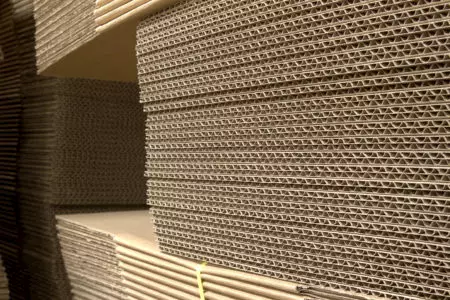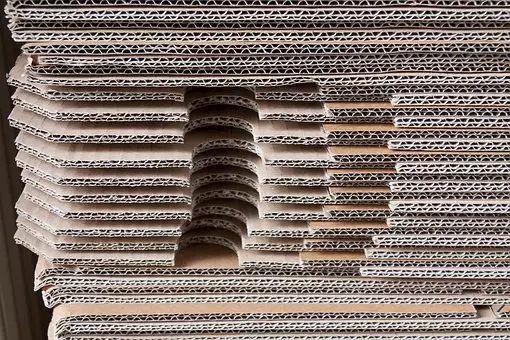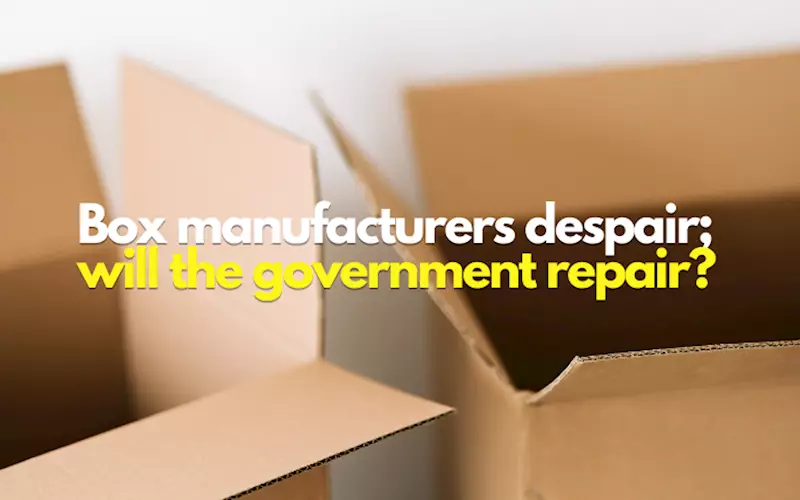Box manufacturers despair; will the government repair?
The Rs 27-crore corrugated box industry has urged the government to ban the exports of recycled kraft paper pulp rolls that will help in the availability of raw materials in the country and control the surge in prices. Sriraam Selvam reports from Chennai
30 Apr 2021 | By Sriraam Selvam & WhatPackaging? Team
First the stats. At the end of 2020, there was a “record- breaking” holiday season for Amazon. They delivered 1.5 billion packages worldwide over the festive period. As a result, Amazon and other big retailers have snapped up most of the world’s cardboard supply to fulfil online orders.
And so, smaller businesses are unable to get their hands on boxes of their own. WhatPackaging? readers will recall that the price of corrugated cardboard, which is old boxes that can be reused to make new ones, has trebled in the last year from Rs 1,850 a tonne to Rs 5,500 a tonne. Which is why, the month of March saw some of the state-level box manufacturers association across India on a strike.
Box makers on strike
The South India Corrugated Box Manufacturers’ Association (SICBMA) has urged the Centre to impose an immediate ban on kraft paper exports of all forms. G Nagaraj, president, SICBMA, said: “There are about 2,000 units in Tamil Nadu and Puducherry engaged in the manufacture of corrugated boxes. They employ nearly one lakh people – about 60% of them are women. “The cost of kraft paper typically accounts for 85% of the production cost of corrugated boxes.
With the steep rise in the price of kraft paper, triggered largely by the export-led shortage, the cost of manufacturing corrugated boxes has risen by 60%.” Nagaraj added that being a highly competitive sector producing an essential packaging product, the box manufacturers work on a very thin margin.
“Most industries can neither accommodate the sudden rise in the raw material cost nor pass it onto the end customers. Unless export is banned and supply of kraft paper is ensured, many industries will have to wrap up their business.” Rajesh Bhatia, who is the president of the Uttar Pradesh Corrugated Box Manufacturers Association, held a press conference in Varanasi.
Bhatia said that in the past three to four months, the price of kraft paper, which is the main raw material deployed in the packaging industry, has increased by almost 60%. The association requested the Varanasi member of parliament and Prime Minister of India Narendra Modi, to look into this matter and take action vis-a-vis the unprecedented rise in the value of kraft paper.
Harish Madan, vice president, Indian Corrugated Case Manufacturers’ Association (ICCMA)
The demand gap and attractive pricing in China are diverting the output of Indian kraft paper from the domestic market and driving up the domestic prices of finished paper and recycled fibre. Exports of recycled kraft paper pulp rolls by Indian kraft paper mills would touch about two million tonnes this year, roughly 30% of total domestic kraft paper production in India.
This development, on the base of zero export prior to 2018, is a game-changer in supply-side dynamics going forward. In addition to the increase in the costs of kraft paper other conversion costs such as man-power costs, starch and freight have also witnessed a huge increase by 60-70% over the past few years. China’s burgeoning demand for kraft pulp rolls is pushing at least 20% of Indian box makers on the brink of closure.
The message is simple: Please save us. Likewise, Rajendra Mittal, the president of the Indore Paper Traders Association said, "Supplies from mills have declined sharply. We are receiving less than half of the ordered materials from mills. A drop in availability of pulp and freight has scaled up prices."
Sanjeev Sureka, president of Madhya Pradesh Corrugated Box Manufacturers’ Association, said, "The costs of raw material, be it paper, starch or other items, have risen. It has lifted the manufacturing cost. We are contemplating an increase in the prices of corrugated boxes."
“This industry worked 24/7 from day one of the lockdown. They were the first to start the factories as per the government of India SOP and guidelines. Brown box manufacturing is essential because it can pack items such as food, medicines, sanitisers, and more.

One of the downsides of the pandemic was it negatively affected the recycling industry
We are talking about 10,000 factories, which directly and indirectly feed lakhs of families.” When this scribe conducted a telephonic interview with a major box manufacturer from Chennai, he said five things: One, paper mills have formed a cartel; two, all mills have a uniform stance on the price increase; three, there is a shortage because these domestic mills are exporting paper to China and South Korea; four, this rise in exports has resulted in a shortage of recyclable paper scrap, which otherwise would have been generated locally if the produce was sold locally; and five, there has been a 40% increase in kraft paper rates in the last three months.
This has worrying consequences for the packaging supply chain. Since the first week of March, many mills are giving quotations for paper, which is valid for the next 24 hours. The WhatPackaging? editorial team contacted three major paper mills. But in spite of repeated requests, there was no response.
Swadesh Sharma, president, Indore Master Printers Association
We, the printers, are facing an uncertain market behaviour regarding the pricing of raw materials. This started in October 2020. Today, not only the price, but also the availability of paper and board is a huge challenge. Most packaging box manufacturers have regular orders from our clients, and they are dependent on us for their packaging needs. Now, if we can’t supply, then the dispatch of the big brands will fail. As a result, we will lose our long-term contracts, plus future orders.
What about recycling
One of the downsides of the pandemic was it negatively affected the recycling industry. Basically, there were interruptions in the recycling systems, which caused a shortage of raw materials in the supply chain. A kraft paper dealer said, “Chinese restrictions on the import of recyclable materials have forced major nation states such as the USA to find new markets for recovered materials, often at a reduced value.” In India, 75% of corrugated cardboard packaging is recycled. It varies from region to region.
But every newly-made cardboard box is made up of around 75% recycled material. The remaining 25% is new, virgin fibre. But now, even the recycled share of the humble cardboard box is taking longer to return to the paper making plants that produce boxes. Pramod Agarwal, president of Indian Agro and Recycled Paper Mills Association (IARPMA) termed the crisis as a “burning issue” and blamed the waste paper suppliers for jacking up raw material prices.
According to IARPMA, the recycled fibre-based segment of the industry is facing scarcity of waste paper and this basic raw material for the industry is a burning issue at present. The waste paper suppliers are controlling the prices and as a result the paper mills have no option, but to cut their paper production according to the raw material availability and stock inventory. “No doubt this situation of waste paper shortage and uncontrolled pricing may stretch during the year 2021,” IARPMA stated.

Brown box manufacturing is essential because it can pack items such as food, medicines, sanitisers
Agarwal says that it was expected that the price of waste paper will reasonably surge due to a shortage of supply in the post-Covid era. The increase in kraft waste paper prices has reached Rs 22 per kg, which was Rs 10 during the pre-Covid period.
He adds, “The industry is not in a position to absorb this uncontrolled price increase, as now it is being procured at Rs 22-24 per kg by the industry. It is also not able to pass on the price hikes to the end users, particularly due to the prevailing situation in the country.” The woes multiply Another pandemic-related issue in the supply chain is the lack of containers to shipping recyclable material to countries that would accept it, such as India. Right now, there is a massive increase in freight costs even when containers are available.
Sandeep Wadhwa, president, Indian Corrugated Case Manufacturers’ Association (ICCMA)
The industry is reeling under the twin blows of a sharp rise in raw material as well as disruptions in its supply. The exports of kraft paper from India to China have surged as China has banned the import of waste paper from 1 January 2021. Exports from India are in the form of recycled kraft paper pulp rolls. This has created a huge shortage of raw material for the domestic corrugated industry.
There is a need for the government to step in and ban exports of recycled kraft paper pulp rolls, as the domestic corrugated industry that gives employment to over six lakh people is on the verge of closure
These and other supply chain issues have prompted increased costs for recycled paperboard. Fewer cardboard boxes being recycled in a timely, clean manner means less supply for the manufacture of new cardboard boxes – this is one of the root causes of the present crisis. The WhatPackaging? team conducted a few interviews in March- April. The message from the ground is:
“It is all about survival. If this continues, many firms may have to down their shutters and lock their factory gates.” During FICCI’s Foodworld India conference, the top food brands alluded to this crisis in their presentations. They indicated that the cardboard shortage could lead to delays in deliveries, damaged parcels and increased charges – a serious crisis. Meanwhile, the woes surge.











 See All
See All